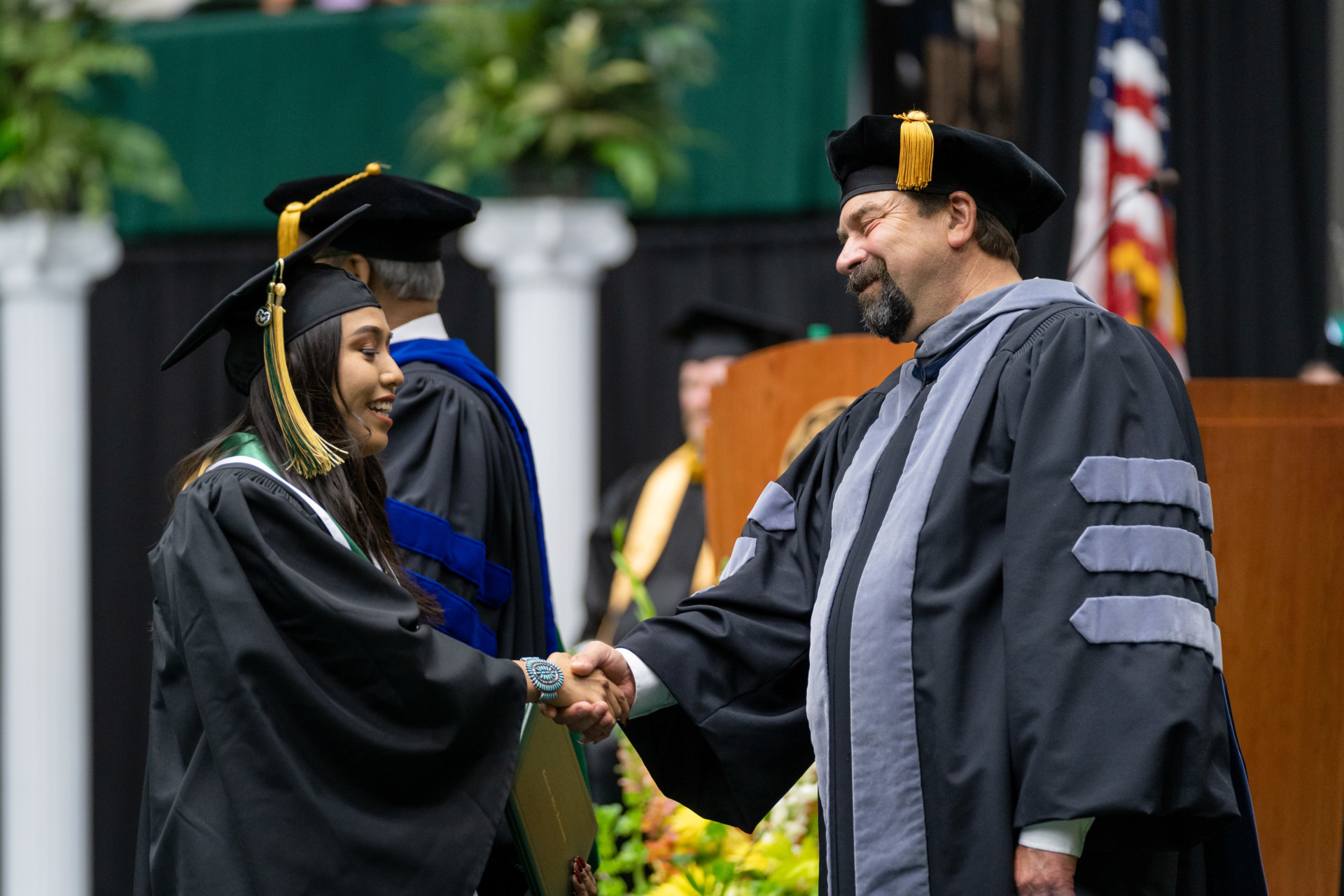CSU Tuition Assistance Grant
CSU Tuition Grant celebrates 10 years of making higher education affordable and accessible by Tony Phifer published July 27, 2020Colorado State University System Chancellor Tony Frank is rarely at a loss for words. His public speaking skills are extraordinary, and his behind-the-scenes ability to inform and influence are legendary.
So, it was noteworthy when the former president of the CSU’s flagship campus in Fort Collins paused for several seconds to ponder a number shared with him.
“Nineteen thousand? We’ve helped 19,000 kids?” he said. “I had no idea it was that many. Wow … 19,000!”
That number – it’s actually 19,539 – is how many students have taken advantage of a program established 10 years ago during the first years of Frank’s presidency. It was called Commitment to Colorado at the time – a landmark financial aid plan established to make a CSU education accessible for qualified low-income students in the state. It’s now known as the CSU Tuition Assistance Grant.
The grants were designed to make in-state tuition affordable for students who thought a CSU education was beyond their financial reach. What made the Commitment to Colorado so revolutionary was that it was unveiled at the height of the Great Recession, when colleges across the country were scrambling to save money, not hand it out to students.
“I officially became president in June of 2009 during a Board of Governors meeting at the Mountain Campus,” he said. “The Great Recession was upon us, and even though we had sort of managed our way through the first half a year, we were facing significant challenges. Nobody knew where the bottom was. It was not a fun time.”
But Frank, working with BOG chair Pat McConathy, chiseled out the details that not only put CSU on a path to unprecedented growth and financial stability, it opened the door to thousands of Colorado students who otherwise might not have gone to college. That first year, 2011, 4,425 students took advantage of the program.
An unlikely alliance

The CSU Tuition Assistance Grant was established 10 years ago during the first years of Tony Frank’s presidency at CSU.
When McConathy first joined the BOG in 2007, he was an unknown entity, with no ties to CSU or to higher education in the state.
“All I knew was that Pat was an oil man from Louisiana, and that he was on the board for Middlebury College – a place that has very little in common with CSU,” Frank, who was CSU provost at the time, said, admitting he was a bit wary.
McConathy was more terrified than wary. He literally had been tabbed by then-Gov. Bill Ritter to fill a board opening the day before the BOG meeting. He knew nothing about CSU, did not know anyone on the board and had never been to Fort Collins.
“I had to look it up on the map before I left from my house (in Denver) for the meeting,” he said. “All I knew was Middlebury, and all Tony knew of me was that I was the guy who always kept saying, ‘raise tuition.’ That’s what we did at Middlebury when we needed money.”
McConathy also knew Frank as the guy who was always stressing the importance of the land-grant mission and the promise to provide access to everyone qualified. Raising tuition made access, well, less accessible. But CSU, like the rest of the country, was in dire financial straits and needed to figure out a way to move forward.

When McConathy was named BOG chair in 2009 – on the same day Frank was named CSU’s president – this unlikely duo came together with a common goal: pushing the university toward greatness while keeping it affordable. Frank began to hammer out a plan.
“At the time, resident and non-resident tuition at CSU were below national averages, but the state was cutting back on its support of higher education,” Frank said. “Our plan was to build enrollment and bring tuition to national averages, which would insulate us from funding cuts by the state.
“My primary concern with the plan was that we would price out low-income kids. Pat and (then-Chancellor) Joe Blake fully supported the plan to get bigger, but we had to make sure to push some of that new money back to help low-income kids. That’s how the plan was born.”
Here’s an ironic twist to the tale: McConathy, who claimed no knowledge of the land-grant mission, graduated from Louisiana State University – the land-grant school in his home state. And like many students at land-grant schools, he grew up in a very modest home; both parents were teachers.
“When I look back, I couldn’t have gone to college if I hadn’t gone to a land-grant school,” he said. “The more I worked with the BOG, the more everything in that land-grant mission started to resonate with me. I wanted to make sure CSU helped kids like me and gave them a chance to improve their lives – and their families’ lives.
“When I look back at my time on the board, that’s the program that makes me proudest.”
The investment pays off

CSU graduate Violeta Flores, who was a recipient of the Tuition Assistance Grant, now works for Lockheed Martin in Englewood, Colorado.
Ten years later, CSU has invested more than $160 million in the program. The rest of the money comes from state and federal funding – roughly each entity paying one-third of the cost. The average grant is $5,315 dollars, but some are larger and some smaller.
Nearly 20 percent of all incoming freshmen qualify for the program, and the Office of Financial Aid goes out of its way to make sure everyone eligible takes advantage.
Among the thousands who have benefitted from the program is Violeta Flores, who graduated in May from the Walter Scott, Jr. College of Engineering with a degree in electrical engineering. She was the first in her family to attend college and chose CSU – in part because of the CSU Tuition Assistance Grant.
“As someone who didn’t have the means to pay for college, that Tuition Assistance Grant, among other scholarships, definitely helped me to not always have to work 40 hours a week while going to school,” she said. “It allowed me to pay for my dorm, pay for my tuition, pay for my books. It was just something that I didn’t have to worry about.”
Flores, who grew up in Colorado Springs, now works for Lockheed Martin in Englewood, Colorado, in electrical ground support systems for hypersonic missiles.
More than financial support
Thanks to programs within CSU’s Student Success Initiative that help students earn degrees, those who receive CTAG funds graduate at a rate just 3% below that of the overall student body. Considering that many of them are first-generation students without strong academic support from within their families, that rate is particularly impressive.
“That 3% is a good number,” Frank said. “We should take a minute and be proud of it – then roll up our sleeves and work to make it zero.”
“That 3% is a good number. We should take a minute and be proud of it – then roll up our sleeves and work to make it zero.”
— Tony Frank, CSU System chancellor
CTAG has become a valuable recruiting tool, helping CSU attract the best and brightest – students like Flores, who was accepted at 19 of the 21 colleges to which she applied. So, not only is CSU providing opportunities to all qualified students, CTAG makes it possible for the cream of the crop to become Rams.
Leslie Taylor, vice president of Enrollment and Access, is concerned, however, that the COVID-19 pandemic once again has low-income students thinking they can’t afford a CSU education. Even though she knows many students’ parents have lost their jobs, she’s encouraging students to contact the Office of Financial Aid and work with counselors there to take advantage of CTAG and find a solution.
“It is such a privilege to be part of an institution that so fully embraces the land-grant mission – and not just by words, but also through persistent effort, active planning, allocation of resources and a growing accountability of outcomes,” she said. “CTAG is among the best demonstrations of that commitment to our students.”
Looking back
The plan hatched by Frank, McConathy and countless others across campus 10 years ago seemed radical at the time but now has been embraced, in various forms, by other colleges and universities across the country, including CSU-Pueblo.
And while Frank accomplished many things during his tenure – the physical transformation of campus, the addition of hundreds of new scholarships, expanded enrollment, $1.6 billion in private donations, etc. – CTAG still holds a special place in his heart. Like McConathy, he takes great pride in what the program has become and the people it has served.
“CTAG is one of the things I’m proudest of,” he said. “Like a lot of those moments, it seemed very important at the time – and it turns out that we were right. To think that 19,000 kids had a chance to come here because of that program – and the ripples that has caused for them and their families that will last for generations – well, if you’re not proud of that you probably should find a different line of work.”